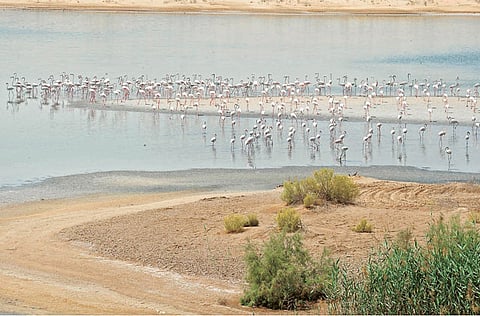Keeping Al Wathba alive and buzzing
EAD using GPS technology to monitor wetland's environment, flora and fauna

Abu Dhabi: It was established to provide a suitable habitat for migratory birds and protect several species of flora and fauna.
Today, Al Wathba Wetland Reserve, spread over five square kilometres is dotted with natural and man-made water bodies.
It was declared a protected wetland reserve in 1998 by Shaikh Zayed Bin Sultan Al Nahyan,
Approximately 250 species of birds can be found in Al Wathba. It is also home to several species of reptiles, small mammals and insects, and is one of the two areas in the UAE where flamingos breed.
A detailed Development Master Plan of the reserve was developed in 2008 aimed at creating a new tourism destination.
Caring for this natural habitat is a task taken seriously by the Environment Agency Abu Dhabi (EAD). Earlier this month, the EAD launched a survey to establish a baseline for long-term monitoring of terrestrial biodiversity and habitat in the reserve.
Satellite images
Dr Richard Perry, executive director of the environmental information science and outreach management at EAD, told Gulf News: "This is a large project that will involve several teams. It aims to develop a comprehensive and reliable database, to create environmental data model and geo-database terrestrial baseline survey and provide a meticulous and detailed understanding of the environment including plants, animals, mangroves… etc.
"This project will help authorities in implementing framing policies and regulations and assessing their success."
"We are working with the Abu Dhabi Global Environmental Data Initiative [AGEDI] to adopt a framework that can be scaled to a global level," he added.
The project will include environmental data collection base mapping, grid design... etc, using multiple methods and advanced technologies.
"EAD recognised the benefits of using satellite images right from its inception. The images are used to detect and record habitat changes. They will also serve mapping land use and land cover mapping, water resources studies, forestry studies… etc," said Hossam Al Alqawi, senior biodiversity geographical information systems analyst.
Al Alqawi said: "One of the advanced technology we are using on field is a device that has a mobile [Geographic Information System] GIS connected to EAD server so data is directly collected and updated as it has a GPS enabled so we have a direct access in the field to the GIS format which spare time and effort."
Smaller units
"We are dealing with a huge area so we needed to have a system to divide it into smaller units easier to handle and reference. We have 10,000 survey grids across the emirate to perform the study," Maher Kabshawi, scientist, told Gulf News.
The device has also an incorporated safety feature so in case of accidents it can detect where staff are.
An important objective of the research is to collect and identify various types of animals and insects.
Anita Sagi, an insect specialist, said one way to attract invertebrates is to insert in a hole a container with vinegar, which is environmentally friendly, but its smell attracts insects. The containers are emptied and replaced every two weeks.
"We got in one of the holes a black fat tail scorpion, one of the most poisonous scorpions found in the UAE. It can kill, its impact on humans depends on the person's health status," said Sagi.
Native species
Two species of scorpions were recorded at the AWR out of six species in the UAE. Ultraviolet light is used to attract nocturnal insects.
"We recorded over 400 species of plants out of which 32 native species in AWR. Zygophyllum is the most common plant in AWR and throughout the emirate. It's succulent and is food for camels," said Sabit Sakkir, an assistant scientist.
The project will focus on the Western Region — the only area in the UAE where dew forest can be found.
The project will involve members of the community after adequate training which is done to ensure the process of data collection is done properly with minimal damage to the habitat of animals and plants.
"We will design special services for community members including schools and university students, non-profit organisations, amateurs who have some knowledge. We will put in place a hotline and framework that engage the community," said Perry.
The reserve is approximately 40km south-east of Abu Dhabi and 3km from Mussafah. It is not open to the public, but receives a limited number of student groups and bird-watchers.
Volunteers can sign in through the EAD website www.ead.ae
Sign up for the Daily Briefing
Get the latest news and updates straight to your inbox



